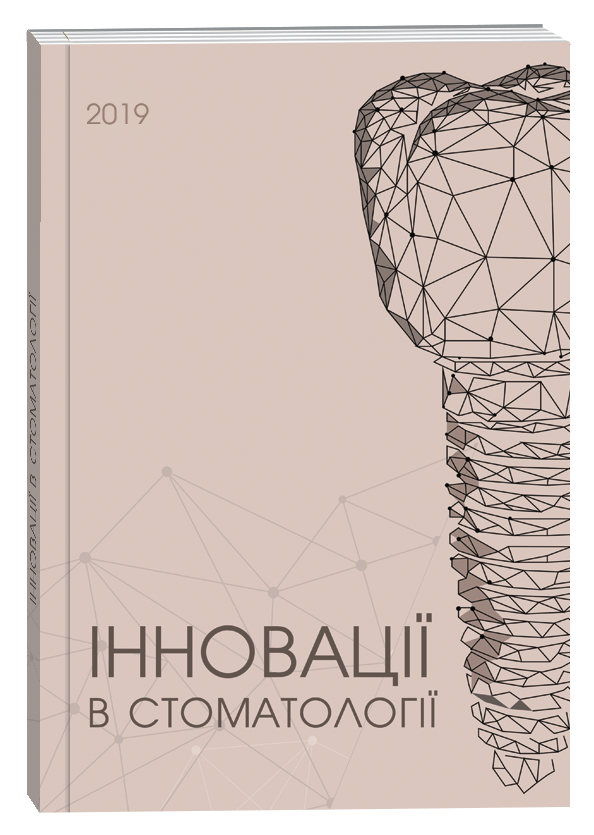CLINICAL RATIONALE FOR USING ANTI-DYSBIOTIC MEDICINE "LYSOZYME-FORTE" IN THE COMPLEX TREATMENT OF PATIENTS WITH THE SALIVARY GLANDS DISEASES ON THE BACKGROUND OF HEPATOBILIARY PATHOLOGY
DOI:
https://doi.org/10.35220/2523-420X/2019.1.3Keywords:
hepatobiliary pathology, sialosis, oral fluid, salivary glandsAbstract
Salivary glands clearly respond to pathological changes in the hepatobiliary system manifested by changes in the quantity and quality of salivation.
The purpose of our study was to determine the effectiveness of the anti-dysbiotic hepatoprotector "Lysozyme-Forte" on the condition of salivary glands and oral organs in patients with sialosis on the background of hepatobiliary pathology.
Material and methods. 90 people were examined, including 66 patients with treatment for pathology of the hepatobiliary system who were diagnosed with sialosis of the parotid gland. To compare the results of the study, 24 healthy individuals were involved. The state of the hepatobiliary system was assessed by biochemical examination of the blood serum of the examined patients. The degree of inflammation was determined on the basis of biochemical marker of inflammation (MDA), antioxidant enzyme catalase. Antioxidant-prooxidant index and degree of dysbiosis were determined. The oral hygiene index, papillary-marginal-alveolar index and bleeding index were determined. The condition of salivary glands was diagnosed using the data of biochemical study of unstimulated oral fluid, salivation rate and pH of mixed saliva.
Results and discussion. The study presented the results of the determination of inflammation markers in the oral fluid (MDA, catalase), antioxidant defense (API), microbial contamination (urease), lysozyme activity and degree of dysbiosis. The obtained results showed that the level of markers of inflammation of MDA, urease and the degree of dysbiosis significantly increased in patients with hyperkinesis. Basic treatment reduced this indicator. However, the main group patients who used the drug "Lysozyme-Forte" in addition to the main treatment were more likely and close to the indicators in a group of practically healthy individuals. The level of catalase, lysozyme and API was significantly reduced in patients with pathology of the hepatobiliary tract. The performed treatment increased these indicators. However, we achieved a more pronounced effect using "Lysozyme-Forte", which brings them closer to similar data in the control group.
Conclusion. Taking into account the results of the studies, we assumed that patients with hepatobiliary pathology had a disease of the salivary glands and oral organs. It was proved that hyposalivation increased the likelihood of peri-odontal disease. The inclusion in the complex therapy of the antidisbiotic drug "Lysozyme -Forte" significantly im-proved the studied parameters in these individuals, which gave reason to recommend it for clinical use for the preven-tion and treatment of sialosis and pathology of the hepatobiliary tract.
References
Gorbacheva A.I., Kirsanov A.I., Orekhova L.Yu. Edinstvo sistemnykh patogeneticheskikh mekhanizmov pri zabolevaniyakh vnutrennikh organov, assotsiirovannykh s generalizovannym parodontitom. Stomatologiya. 2005; 5: 24-9. [Russian]
Nemesh O.M., Honta Z.M., Shylivskyi I.V., Skalat A.P. Zv’yazok zakhvoryuvan parodonta z zahalnosomatychnoyu patolohiyeyu (ohlyad literatury). Novyny stomatolohiyi. 2006; 2: 34-7. [Ukrainian]
Kalinichenko Yu.A., Sirotchenko T.A. Vzayemozv’yazok ta vzayemovplyv stomatolohichnoho ta somatychnoho zdorov’ya ditey ta pidlitkiv yak suchasna medyko-sotsialna problema. Zdorove rebenka. 2010;3:11-2. [Ukrainian]
Levitskiy A.P., Demyanenko S.A. Rol pecheni v patogeneze i lechenii stomatologicheskikh zabolevaniy. Visnik stomatologiyi. 2008; 5-6: 124-8. [Russian]
Trufanov S.Yu. Kontsentratsiya imunohlobuliniv u rotohlotochnomu sekreti khvorykh na khronichnyi parodontyt, spoluchenyi z khronichnoyu patolohiyeyu hepatobiliarnoi systemy. Ukrainskyi medychnyi almanakh. 2009; 12(2): 181-3. [Ukrainian]
Levytskyi A.P, Dem’yanenko S.A., Tsyselskyi Yu.V. Antymikrobna funktsiya pechinky. Odesa; 2011. 141 p. [Ukraini-an].
Vasilev A.Yu., Shevchenko L.M., Maychuk V.Yu. i dr. Stomatologicheskiy status bolnykh s khronicheskimi diffuznymi zabolevaniyami pecheni. Stomatologiya. 2004;83(3): 64-7. [Russian] 8. Denysov A.B. Slyna ta slynni zalozy. M: RAMN; 2006. 372 p. [Ukrainian]








